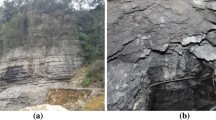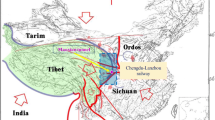Abstract
Large deformation and support failure of a tunnel with poor lithology, which significantly threaten the stability of the tunnel, have always been major difficulties in underground engineering construction. This paper describes a case study of the failure mechanisms and support design for tailrace tunnels that cross a wide fracture zone in the Wuyue pumped storage power station in Henan Province, China. Geological investigation and mechanical experiments, including large-scale triaxial tests, X-ray diffraction, and free swell tests, were performed to reveal the failure mechanism of the tailrace tunnel. It was observed that the surrounding rock of the tunnel is a completely weathered granite that is characterized by extremely poor rock mass quality, severe deformation, and significant expansibility. Based on the failure mechanism and combined with the concept of “inner and outer load-bearing structures”, a multilevel support system with “long anchor bolts + anchor bolts + rigid arch” as a core is proposed with consideration of the rotation of the principal stress axis. Numerical simulation was adopted to verify the rationality of the proposed support system compared with other support conditions, i.e. no support and uniform support. The results indicate that the proposed support system effectively improves the principal stress state of a tunnel with poor lithology and controls the large deformation of the surrounding rock, especially in the floor and inclined sidewall. Additionally, three successful application cases were introduced to promote the utilization of the proposed support, and possible improvements in enhancing engineering applications were evaluated. The support methodology presented in this paper can support the design of other engineering projects in complex geological environments.


























Similar content being viewed by others
Data availability
The data used to support the findings of this study are available from the corresponding authors upon request.
References
Agbay E, Topal T (2020) Evaluation of twin tunnel-induced surface ground deformation by empirical and numerical analyses (NATM part of Eurasia tunnel, Turkey). Comput Geotech 119:103367. https://doi.org/10.1016/j.compgeo.2019.103367
Bagherzadeh P, Goshtasbi K, Kashef M (2020) Umbrella arch method performance, structural behavior and design elements utilizing in collapsing zones. Environ Earth Sci 79:521. https://doi.org/10.1007/s12665-020-09266-y
Barsanescu P (2015) Extension of Mohr-Coulomb theory for ductile materials. Exp Mech 55(7):1389–1393. https://doi.org/10.1007/s11340-015-0026-0
Bonini M, Barla G (2012) The Saint Martin La Porte access adit (Lyon-Turin Base Tunnel) revisited. Tunn Undergr Sp Tech 30:38–54. https://doi.org/10.1016/j.tust.2012.02.004
Chen SM, Wu AX, Wang YM, Chen X, Yan RF, Ma HJ (2018) Study on repair control technology of soft surrounding rock roadway and its application. Eng Fail Anal 92:443–455. https://doi.org/10.1016/j.engfailanal.2018.06.006
Coggan J, Gao FQ, Stead D, Elmo D (2012) Numerical modelling of the effects of weak immediate roof lithology on coal mine roadway stability. Int J Coal Geol 90:100–109. https://doi.org/10.1016/j.coal.2011.11.003
Du SH, Li DY, Yu WJ, Zhang J, Liu FF (2019) Stability analysis and support control for a jointed soft rock roadway considering different lateral stresses. Geotech Geolog Eng 38:237–253. https://doi.org/10.1007/s10706-019-01013-w
Du SH, Li DY, Zhang CS, Mao DW, Ruan B (2021) Deformation and strength properties of completely decomposed granite in a fault zone. Geomech Geophys Geo 7:13. https://doi.org/10.1007/s40948-020-00210-9
Duncan JM, Chang CY (1970) Nonlinear analysis of stress and strain in soils. J Soil Mech Found Div 96(5):1629–1653
Gschnitzer E, Goliasch R (2009) TBM modification for challenging rock conditions – a progress report of the Niagara Tunnel Project (NTP). TBM-Umbau unter schwierigen Gebirgsbedingungen – ein Baubericht über das Niagara Tunnel Projekt (NTP). Geomech Tunn 2:168–178
He SY, Lai JX, Zhong YJ, Wang K, Xu W, Wang LX, Liu T, Zhang CP (2021) Damage behaviors, prediction methods and prevention methods of rockburst in 13 deep traffic tunnels in China. Eng Fail Anal 121:105178. https://doi.org/10.1016/j.engfailanal.2020.105178
Huang WP, Yuan Q, Tan YL, Wang J, Liu GL, Qu GL, Li C (2018) An innovative support technology employing a concrete-filled steel tubular structure for a 1000-m-deep roadway in a high in situ stress field. Tunn Undergr Sp Tech 73:26–36. https://doi.org/10.1016/j.tust.2017.11.007
Hudson JA, Harrison JP (1997) Engineering rock mechanics–an introduction to the principles. Pergamon Press
Jia HS, Wang LY, Fan K, Peng B, Pan K (2019) Control technology of soft rock floor in mining roadway with coal pillar protection: a case study. Energies 12:3009. https://doi.org/10.3390/en12153009
Jiang Y, Zhou H, Lu JJ, Gao Y, Zhang CQ, Chen J (2019) Analysis of stress evolution characteristics during TBM excavation in deep buried tunnels. Bull Eng Geol Environ 78:5177–5194. https://doi.org/10.1007/s10064-019-01466-6
Kabwe E, Karakus M, Chanda EK (2020) Proposed solution for the ground reaction of non-circular tunnels in an elastic-perfectly plastic rock mass. Comput Geotech 119:103354. https://doi.org/10.1016/j.compgeo.2019.103354
Kang HP, Lin J, Fan MJ (2015) Investigation on support pattern of a coal mine roadway within soft rocks – a case study. Int J Coal Geol 140:31–40. https://doi.org/10.1016/j.coal.2015.01.003
Lee J, Rehman H, Naji AM, Kim JJ, Yoo HK (2018) An empirical approach for tunnel support design through Q and RMi systems in fractured rock mass. Appl Sci 8:2659. https://doi.org/10.3390/app8122659
Liu J, Xiang YZ, Xiong YC, Wu ZS, He C (2020) Theoretical and numerical study of shear strength of concrete material. J Eng Sci Technol Rev 13:161–168. https://doi.org/10.25103/jestr.135.21
Liu XQ, Liu JK, Tian YH, Chang D, Hu TF (2019) Influence of the freeze–thaw effect on the Duncan-Chang model parameter for lean clay. Transp Geotech 21:100273. https://doi.org/10.1016/j.trgeo.2019.100273
Luo YB, Chen JX, Shi Z, Li JZ, Liu WW (2020) Mechanical characteristics of primary support of large span loess highway tunnel: a case study in Shaanxi Province, Loess Plateau, NW China primary. Tunn Undergr Sp Tech 104:103532. https://doi.org/10.1016/j.tust.2020.103532
Manouchehrian A, Cai M (2018) Numerical modeling of rockburst near fault zones in deep tunnels. Tunn Undergr Sp Tech 80:164–180. https://doi.org/10.1016/j.tust.2018.06.015
Mao DW, Du SH, Li DY, Shi BX, Ruan B (2020) Mechanical behaviors and wetting-induced deformation of metamorphic granite based on large-scale triaxial test. Chin J Rock Mech Eng 39:1819–1831. https://doi.org/10.13722/j.cnki.jrme.2020.0175
Marinos V, Goricki A, Malandrakis E (2018) Determining the principles of tunnel support based on the engineering geological behaviour types: example of a tunnel in tectonically disturbed heterogeneous rock in Serbia. Bull Eng Geol Environ 78(4):2887–2902. https://doi.org/10.1007/s10064-018-1277-7
Mohammadi H, Azad A (2021) Prediction of ground settlement and the corresponding risk induced by tunneling: an application of rock engineering system paradigm. Tunn Undergr Sp Tech 110:103828. https://doi.org/10.1016/j.tust.2021.103828
Mu WQ, Li LC, Chen DZ, Wang SX, Xiao FK (2020) Long-term deformation and control structure of rheological tunnels based on numerical simulation and on-site monitoring. Eng Fail Anal 118:104928. https://doi.org/10.1016/j.engfailanal.2020.104928
Ngoc-Anh D, Dias D, Oreste P (2015) 3D numerical investigation on the interaction between mechanized twin tunnels in soft ground. Environ Earth Sci 73:2101–2113. https://doi.org/10.1007/s12665-014-3561-6
Panthi KK (2012) Evaluation of rock bursting phenomena in a tunnel in the Himalayas. Bull Eng Geol Environ 71(4):761–769. https://doi.org/10.1007/s10064-012-0444-5
Panthi KK, Nilsen B (2007) Uncertainty analysis of tunnel squeezing for two tunnel cases from Nepal Himalaya. Int J Rock Mech Min 44(1):67–76. https://doi.org/10.1016/j.ijrmms.2006.04.013
Ren MY, Zhang QY, Zhang LY, Wang WS (2021) Experimental study on rock-support interaction in deep tunnel under complex geological conditions. Geotech Geolog Eng. https://doi.org/10.1007/s10706-021-01724-z
Schwingenschloegl R, Lehmann C (2009) Swelling rock behaviour in a tunnel: NATM-support vs. Q-support – a comparison. Tunn Undergr Sp Tech 24(3):356–362. https://doi.org/10.1016/j.tust.2008.08.007
Shi HY, Ma ZK, Zhu QJ, Shi JJ, Zhao ZQ (2020) Comparison of shape characteristics of plastic zone around circular tunnel under different strength criteria. J Mech 36:849–856. https://doi.org/10.1017/jmech.2020.45
Shrestha PK, Panthi KK (2014) Assessment of the effect of stress anisotropy on tunnel deformation in the Kaligandaki project in the Nepal Himalaya. Bull Eng Geol Environ 74(3):815–826. https://doi.org/10.1007/s10064-014-0641-5
Srivastava LP, Singh M (2015) Empirical estimation of strength of jointed rocks traversed by rock bolts based on experimental observation. Eng Geol 197:103–111. https://doi.org/10.1016/j.enggeo.2015.08.004
Vazquez-Silva D, Prendes-Gero MB, Alvarez-Fernandez MI, Gonzalez-Nicieza C, Lain-Huerta C, Lopez-Gayarre F (2020) Optimal support design for galleries located in poor quality rock mass and under the influence of mining works. Arch Min Sci 65(4):851–867. https://doi.org/10.24425/ams.2020.135181
Wang F, Liu HT, Zhang SK, Sun JH, Li YJ, Cai M (2014) Yieldable technology of lengthened bolts for high-stress soft rock roadways. Chin J Geotech Eng 36:1666–1673. https://doi.org/10.11779/cjge201409013
Wang H, Jiang C, Zheng PQ, Zhao WJ, Li N (2020) A combined supporting system based on filled-wall method for semi coal-rock roadways with large deformations. Tunn Undergr Sp Tech 99:103382. https://doi.org/10.1016/j.tust.2020.103382
Wang Q, Jiang B, Li SC, Wang DC, Wang FQ, Li WT, Ren YX, Guo NB, Shao X (2016) Experimental studies on the mechanical properties and deformation & failure mechanism of U-type confined concrete arch centering. Tunn Undergr Sp Tech 51:20–29. https://doi.org/10.1016/j.tust.2015.10.010
Wang Q, Jiang B, Pan R, Li SC, He MC, Sun HB, Qin Q, Yu HC, Luan YC (2018) Failure mechanism of surrounding rock with high stress and confined concrete support system. Int J Rock Mech Min Sci 102:89–100. https://doi.org/10.1016/j.ijrmms.2018.01.020
Wu GJ, Chen WZ, Jia SP, Tan XJ, Zheng PQ, Tian HM, Rong C (2020) Deformation characteristics of a roadway in steeply inclined formations and its improved support. Int J Rock Mech Min Sci 130:104324. https://doi.org/10.1016/j.ijrmms.2020.104324
Xu J, Li N (2010) Influence of continuous rainfall on surrounding rock-initial support system of shallow decomposed-rock tunnel. Environ Earth Sci 61(8):1751–1759. https://doi.org/10.1007/s12665-010-0638-8
Yang SQ, Chen M, Jing HW, Chen KF, Meng B (2017) A case study on large deformation failure mechanism of deep soft rock roadway in Xin’An coal mine, China. Eng Geol 217:89–101. https://doi.org/10.1016/j.enggeo.2016.12.012
Yuan Y, Wang WJ, Li SQ, Zhu, YJ (2018) Failure mechanism for surrounding rock of deep circular roadway in coal mine based on mining-induced plastic zone. Adv Civ Eng 2018:1–14. https://doi.org/10.1155/2018/1835381
Zhan QJ, Zheng XG, Du JP, Xiao T (2019) Coupling instability mechanism and joint control technology of soft-rock roadway with a buried depth of 1336 m. Rock Mech Rock Eng 53:2233–2248. https://doi.org/10.1007/s00603-019-02027-9
Zhang W, He ZM, Zhang DS, Qi DH, Zhang WS (2018) Surrounding rock deformation control of asymmetrical roadway in deep three-soft coal seam: a case study. J Geophys Eng 15:1917–1928. https://doi.org/10.1088/1742-2140/aabb2a
Zhao ZQ (2014) Mechanism of surrounding rock deformation and failure and control method research in large deformation mining roadway. Dissertation, China University of Mining and Technology
Funding
This work was supported by the National Natural Science Foundation of China (grant number 42202318).
Author information
Authors and Affiliations
Corresponding author
Ethics declarations
Conflict of interest
The authors declare no competing interests.
Rights and permissions
Springer Nature or its licensor (e.g. a society or other partner) holds exclusive rights to this article under a publishing agreement with the author(s) or other rightsholder(s); author self-archiving of the accepted manuscript version of this article is solely governed by the terms of such publishing agreement and applicable law.
About this article
Cite this article
Du, S., Zhang, C., Mao, D. et al. A case study of the failure mechanism analysis and support design of a tailrace tunnel in a weak fracture zone containing expansive minerals. Bull Eng Geol Environ 81, 495 (2022). https://doi.org/10.1007/s10064-022-02984-6
Received:
Accepted:
Published:
DOI: https://doi.org/10.1007/s10064-022-02984-6




